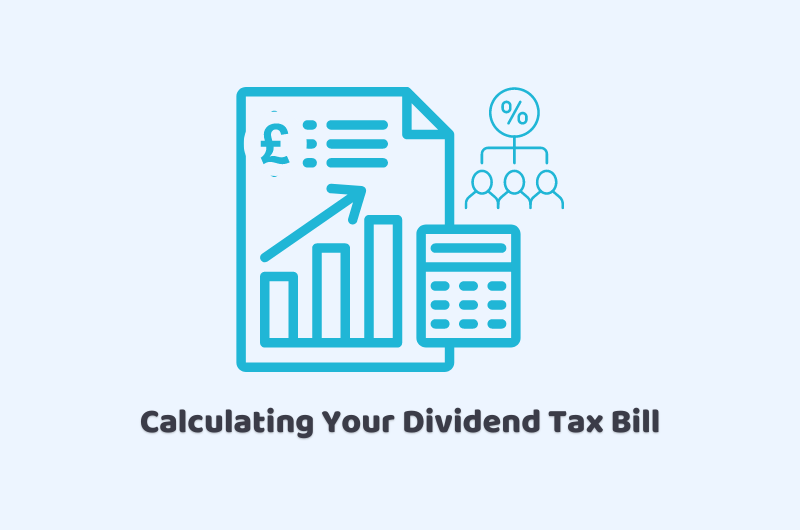
02/11/2022tax , Tax Issues , Taxation
Calculating Tax on Dividends might be confusing and you can commit an error in the calculation of tax on dividend income. Income taxes are relatively easier to calculate. On the other hand, dividend income brings a lot of confusion when it comes to paying taxes on them.
Dividend income is an additional source of income. So, it is possible you have invested in a company and purchased shares or stocks. As a result, you will get regular income in the form of dividends when a company earns a profit.
HMRC taxes these dividends as they are also a source of income for the investors. In this blog, we will help you how to calculate tax on dividends. We will use an example to elaborate on the tax calculation of dividend income. So, let’s start!
Dividend income and taxation on it might be confusing for you. Let’s seek help from the best accountants and tax advisors at CruseBurke. Contact us now!
What are Dividends?
Dividends are the profits shared among the shareholders of a company. A publicly-traded company typically needs capital to run its operations. For this, they can either get capital from the investors or from the debt. Mostly, companies rely on the investors who invest in these companies in return for getting a share in the profits.
These shares in profits are known as dividends. Whenever a company earns profit, the companies either plough back those profits or give the shareholders dividends. The larger corporations usually don’t pay dividends, resulting in the high value of the stock.
The investors enjoy these dividends as it steady stream of income for the shareholders. However, HMRC levies taxes on this additional income source. The tax on dividends is lower than the general income level. There’s also a dividend allowance of £2000, just like an income allowance of £12,570.
What is Dividend Allowance?
A dividend allowance is a tax-free dividend income. In other words, an investor can enjoy the first £2,000 in dividends because it gives them an opportunity to get lower dividends tax-free. In addition to a personal income allowance of £12,570, an investor can also get the £2000 dividend income tax-free.
According to the 2022/2023 tax year, all people who have earned income from dividends up to £2000 are exempt from taxes. If dividend income exceeds this allowance, they will have to pay tax according to their income tax threshold. Similarly, the shareholders cannot pay taxes on their Individual Savings Accounts (ISA).
UK Dividend Tax Thresholds 2022/2023
Each of the income thresholds has a different rate of tax on dividends. The three thresholds calculate the tax on dividends after personal allowance and dividend allowance have been taken into consideration. The following are the UK dividend tax thresholds for 2022/2023:
- Basic Rate taxpayers will pay a dividend tax of 8.75%
- Higher Rate taxpayers will pay a dividend tax of 33.75%
- Additional Rate taxpayer will pay a dividend tax of 39.35%
Example:
Suppose, you’re earning an income of £32,000 and getting a dividend of £3,000 annually. When you will prepare your tax returns, you will have to provide your total income first.
- Your Total Income = £32,000 + £3,000
= £ 35000
- After you have calculated your total income, you will deduct the personal income allowance. The personal allowance is £12,570.
Income after Personal Income Allowance = £ 35000 – £12,570
= £ 22,430
This is the taxable income you will pay tax on.
- Deduct the dividend income from this taxable income and calculate dividend tax and dividend allowance separately now.
Now, you need to deduct the dividend allowance
Taxable income after dividends = £ 22,430 – £3,000
= £ 19, 430
This is the basic rate of income. So, you will calculate a tax of 20%, which is £3,886
- Calculate dividend tax and dividend allowance separately now. This income will help you determine the UK Dividend Tax threshold.
Taxable dividend after Dividend Allowance = £3,000 – £2,000
= £1,000
So, £1,000 is the taxable dividend.
- Because your total income was falling in the basic rate taxpayer threshold, so you will calculate a dividend tax of 8.75% on £1,000. This dividend tax is equal to £87.5
Your total income tax including dividend tax will be
Total tax = £3,886 + £87.5
= £ 3,973.5
The Final Thoughts
Finally, we conclude the discussion that dividend tax calculation is tricky due to the various steps involved in this process. You can also use online dividend tax calculators to avoid the hassle of calculating taxes. It will prevent any errors in the payment of the right amount of taxes.
For this, you need to remember to deduct personal income allowance from your total income. Dividend allowance will be subtracted only from the dividend income. Your taxable income will help determine the right dividend tax.
CruseBurke is the right place to sort out your tax problems instantly and professionally. For more information, feel free to give us a call or send us a message.
Disclaimer: All the information provided in this article on, Calculate tax on dividends, including all the texts and graphics, is general in nature. It does not intend to disregard any of the professional advice.


